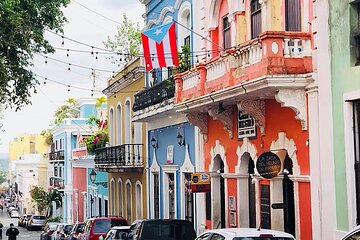Historical Walking Tour of Old San Juan
Share this tour

Offered languages
- Portuguese
- English
- Spanish
Every tour of this magical city is different because Old San Juan is a city filled with rich history and tall tales. We will share the history from fact as well as the tales passed down from generation to generation. Let us transport you through the power of words while guiding you around the place where it actually happened.
What's Included
Meeting and pickup
The meet up point is at Plaza Colon across from the Old Casino.
Itinerary
-
1Paseo de la Princesa
Paseo de la Princesa is considered one of the most scenic walkways in the world. This promenade is imporant because of the important historical sites and statues along the walkway.
15 minutes • Admission ticket not included -
2La Fortaleza - Palacio de Santa Catalina
La Fortaleza (The Fortress) is the official residence of the governors of Puerto Rico. La Fortaleza was the first fortification built in San Juan harbor. The original tower, now called Torre del Homenaje, or "tower of homage," still stands; its name derives from an island tradition in which the resident governor climbs to the top of the tower to pledge a solemn oath of loyalty and courage during dangerous times.
15 minutes • Admission ticket free -
3Catedral Basilica Menor de San Juan Bautista
The cathedral is one of the oldest buildings in San Juan, and the oldest cathedral in the United States, and is the second oldest cathedral in the Americas. The building of the San Juan Cathedral was part of the establishment and spread of Catholicism on the island. The cathedral contains the tomb of the Spanish explorer and settlement founder Juan Ponce de León.
10 minutes • Admission ticket free -
4La Puerta de San Juan
Also known as the (Old Entrance of San Juan), the gate was built in 1635, this gate was the main entry into the walled city during its Spanish colonial era. It is 16 feet tall and 20 feet thick and leads you to the romantic Paseo La Princesa.
10 minutes • Admission ticket free -
5La Rogativa
La Rogativa, one of the most beautiful sculptures in Old San Juan, takes center stage at the plaza. The sculpture was made out of bronze. Rogativa means “The Procession”, which tells the legend about a Catholic Bishop and his companions who made a procession in faith holding crosses, torches, and chanting during an invasion by the British on the city in 1797.
5 minutes • Admission ticket free -
6Casa Blanca Museum
Built in 1521, it was the residence for Juan Ponce de León and his family. Now serves as a museum.
10 minutes • Admission ticket not included -
7
The Bastion was built next to Castillo San Felipe del Morro and it was meant as an added defense to the fort. In the 1800s, this bastion served as barracks for the soldiers.
10 minutes • Admission ticket not included -
8Cuartel de Ballaja
Built in 1854 and used until 1898 by the Spaniards. The Cuartel was built as barracks for the Spanish Infantry. It was made to house 1000 soldiers and their families. After the 1898 invasion by the US Army, the US infantry occupied the Cuartel de Ballajá until 1936. During the Second World War, this structure became a hospital.
20 minutes • Admission ticket free -
9Castillo San Felipe del Morro
El Morro was the second fortress built in Old San Juan to protect the city from attack and invaders. It was built in a strategic position where it could attack ships with cannons from different angles. During the First and Second World Wars, El Morro was used by the US Army and today it serves as a National Park.
45 minutes • Admission ticket not included
Additional info
- Infants and small children can ride in a pram or stroller
- Service animals allowed
- Public transportation options are available nearby
- Not recommended for travelers with poor cardiovascular health
- Travelers should have at least a moderate level of physical fitness
Tags
Cancellation Policy
For a full refund, cancel at least 24 hours before the scheduled departure time.
Show more
Cancellation Policy
- For a full refund, you must cancel at least 24 hours before the experience’s start time.
- If you cancel less than 24 hours before the experience’s start time, the amount you paid will not be refunded.
- Any changes made less than 24 hours before the experience’s start time will not be accepted.
- This experience requires a minimum number of travelers. If it’s canceled because the minimum isn’t met, you’ll be offered a different date/experience or a full refund.
- This experience requires good weather. If it’s canceled due to poor weather, you’ll be offered a different date or a full refund.
Rating
You can cancel up to 24 hours in advance of the experience for a full refund.
Your guide to the flawless travel experience









